A magnificent and fine blue and white 'Dragon' hu-shaped vase, Qianlong six-character mark and of the period (1736-1795)
Lot 3128. A magnificent and fine blue and white 'Dragon' hu-shaped vase, Qianlong six-character archaistic seal mark and of the period (1736-1795); 14 in. (35.5 cm.) high. Estimate Upon Request. Price Realized HK$56,120,000 ($7,267,821). © Christie's Image Ltd 2015
The globular exterior of the vase is finely painted on one side in vibrant cobalt with a three-clawed dragon flanked by two smaller five-flawed dragons amidst an Indian lotus meander. This pattern is repeated on the reverse side. The sloping neck is applied with a pair of moulded dragon handles. The lower body of the vase is decorated with a pattern of crashing waves above a classic band on the low, elegently splayed foot ring, and a similar band of waves below the mouth rim above a register of lotus lappets. Written on the underside base is an underglaze blue six-character reign mark in archaistic script, box.
Provenance: Francis Capel Harrison (1863-1938)
An English private collection, sold at Sotheby's London, 9 November 2005, lot 327
An Exceptional Early Qianlong Blue and White Dragon Vase.
Like his father and grandfather, the Qianlong emperor was a passionate collector of antiques and a great patron of the arts. The porcelains of his reign are known for the range and boldness of their designs and the technical expertise with which they were made and decorated. The Qianlong emperor was also fortunate to have inherited from his father the Yongzheng emperor (1723-35) an extremely able official to supervise the imperial kilns.
In the early years of the Qianlong reign the famous ceramicist Tang Ying (1682-1756) was still at Jingdezhen. Tang Ying was undoubtedly the greatest of all the directors of the Imperial Kiln. His great-grandfather had been a bondservant, but official biographies usually describe him as a Chinese Bannerman. At 16 he entered the Imperial Household Department, and while working in the palace he learned painting, calligraphy, poetry and design, while also having the opportunity to study the imperial collections of painting and decorative arts. When the Yongzheng emperor came to the throne in 1723 Tang Yings rank was raised to that of Vice-Director of the Imperial Household Department, responsible for the artisans in the imperial ateliers. In 1726 Tang Ying was sent to Jingdezhen as resident assistant at the imperial kilns under Nian Xiyao (d. 1738). In 1736, at the beginning of the Qianlong reign Nian Xiyao was removed from office on charges of corruption and Tang Ying took full control and remained in charge of the kilns until his death in 1756. He was a man of great talent as a ceramicist, an administrator, a designer and as a painter, and under his guidance some of the most spectacular porcelains were made at Jingdezhen. It is generally believed that after 1756 the imperial kilns never reached the same heights of quality and innovation. It is significant that the magnificent Qianlong vase in the current sale [Lot 3144] can be ascribed to the early part of the Qianlong reign, when Tang Ying was in office.
fig. 1. A Qianlong celadon-glazed globular vase with relief cord decoration. Collection of the Palace Museum, Beijing
This large pear-shaped vase bears an unusual six-character Qianlong mark, which, archival research suggests, probably ceased to be used after the 12th year of the reign period [1747]. The same distinctive mark appears on four other published vases. One of these is a Qianlong vase with Ge-type glaze with a band tied around the neck, which is in the collection of the National Palace Museum, Taipei (illustrated in Catalogue of a Special Exhibition of Ch'ing-Dynasty Monochrome Porcelains in the National Palace Museum, Taipei, 1981, p. 149, no. 91). The second vessel with this mark is a Qianlong celadon-glazed globular vase with relief cord decoration in the collection of the Palace Museum, Beijing (fig. 1), illustrated in Monochrome Porcelain, The Complete Collection of Treasures of the Palace Museum, Hong Kong 1999, p. 155, no. 140). These two vessels are of particular interest since in the Palace Archives there is an entry dated to the 13th day of the 10th month of the 2nd year of Qianlong reign [1737] which mentions them:
'The forms of the eleven types of porcelain pieces presented by Tang Ying: ...Ge-type-glazed ribbon-tied vaseK.celadon-glazed jar with cord pattern are not desirable, do not make them.'
There is a further entry in the Palace Archives three days later - on the 16th day of the 10th month of the 2nd year of the Qianlong reign - referring to reign marks, which states:
'...a seal mark sample on paper was presented. A decree was issued: going forward, use this mark on all zuns, vases, jars, dishes, small bowls, bowls, small dishes.'
There is a further entry in the Palace Archives dating to the 21st day of the 12th month of the 12th year of the Qianlong reign. This reads:
'Do not use the mark(s) that had been previously approved nor the newly proposed mark(s)... all marks should follow the newly regulated seal mark, though apply this order flexibly, if the pieces bear Ming Xuande marks, then still use Xuande marks...'
fig. 2. Mark of fig. 1
fig. 3 Mark of current lot
It seems likely that the archaistic curvilinear mark seen on the current vase and the four others mentioned above (fig. 2 and 3) was introduced in the 2nd year of the reign [AD 1737], and that it was the one designated 'previously approved mark in the 1747 instruction. In which case it would have been abandoned in favour of the newly regulated seal mark - which would refer to the more frequently-seen regular Qianlong seal mark'- following the instructions given on the 21st day of the 12th month of 1747.
The third published vase with the early curvilinear Qianlong mark is interesting for the additional reason that it shares not only similar size and shape with the current blue and white vase, but also its rare archaic dragons handle form. The published vase is from the Huaihaitang Collection, illustrated in Ethereal Elegance, Porcelain Vases of the Imperial Qing, Hong Kong, 2007, no. 25, and has a delicate Ru-type glaze (fig. 4). The fourth vase with this early Qianlong mark is a yellow-glazed vessel from the same collection, illustrated ibid., no. 54, on which the mark is incised under the yellow glaze of the base, rather than being written in underglaze cobalt blue like the other vessels.
fig. 4. Courtesy of the Huaihaitang Collection
Another aspect of the current vase suggests an early Qianlong date - the choice of decorative motifs. The vase is decorated with dragons amongst lotus scrolls, and unusually two dragons have three claws on each foot, while the others have five claws. This same combination of three- and five-clawed dragons can be seen on two published underglaze blue and overglaze iron red dishes - one dating to the Yongzheng reign and another, extremely similar, dish dating to the Qianlong reign. The Yongzheng example is in the collection of the Palace Museum, Beijing and is illustrated in Blue and White Porcelain with Underglaze Red (III), The Complete Collection of Treasures of the Palace Museum, no. 36, Hong Kong, 2000, p. 245, no. 223 (fig. 5).. The Qianlong dish, which was originally in the Palace Collection but is now in the collection of the Nanjing Museum and is published in Imperial Porcelain of the Kangxi, Yongzheng and Qianlong Reigns, Hong Kong, 1995, no. 81 (fig. 6). The similarity between the two dishes suggests that the Qianlong dish was made early in the reign and adds further weight to the argument that the current blue and white vase with similar decoration also dates to the early Qianlong period.
fig. 5. Collection of the Palace Museum, Beijing.
fig. 6 Collection of the Nanjing Museum.
The shape of this vase, which is based on an archaic bronze hu form, became popular in the Yongzheng reign. In both the Yongzheng and Qianlong reigns these vases were embellished with various styles ofhandle. The specific form of the archaistic dragon handles on the current vase with the heads of the dragons lower than their tails, is rare, but as well as bring seen on the vase with Ru-type glaze and curvilinear mark, mentioned above, similar handles also appear on a pear-shaped vase decorated in underglaze blue and rouge enamel lotus scrolls in the collection of the Palace Museum, Beijing (illustrated in Kangxi Yongzheng Qianlong - Qing Porcelain from the Palace Museum Collection, Hong Kong, 1989, p. 193, no. 22), which dates to the Yongzheng reign. Since the majority of the archaistic dragon handles on similarly-shaped Qianlong vases have the heads above the tails - like those on the hundred deer group (see ibid., p. 338, no. 19) - this is an additional piece of evidence suggesting an early Qianlong date for the current vase.
Before its sale at auction in 2005, this vase has been in English private collections for at least 100 years. In the early 20th century it was in the collection of Francis C. Harrison (1863-1938), who was an official in the Civil Service in India (1884-1911), and in the latter years of his service was appointed Head Commissioner of Paper Currency. When he returned to London he became a politician and a correspondent for the Economic Journal (see R. Davids and D. Jellinek, Provenance - Collectors, Dealer & Scholars: Chinese Ceramics in Britain & America, Great Haseley, Oxfordshire, 2011, p. 223). Along with other items from his collection, Harrison loaned the current vase to the Ashmolean Museum, Oxford -exhibited in 1903 and 1905 - and, according to correspondence preserved in the Ashmolean, it was returned to Harrison by 1925. In 1925 Harrison gave the London dealer Bluetts 130 pieces of monochrome porcelain, which were included in the firms exhibition catalogue of June 1925 A Collection of Old Chinese Monochrome Porcelain (see Davids and Jellinek, op. cit. p. 223). Ceramics from Harrisons collection later entered some of the most prestigious private collections in Britain, including those of the Hon. Mountstuart Elphinstone, Sir Alan Barlow, Samuel Ezekiel and Charles Russell. Another of Francis Harrisons pieces, an octagonal Guan ware vase, which was loaned to the Ashmolean in 1903, was sold by Christies London on 12 October, 1970, lot 90 and is now in the collection of the Osaka Municipal Museum, Japan. When the current vase was sold in London in 2005 it was consigned from 'An English Private Collection.'
This vase therefore has the distinction of a rare mark, an early Qianlong date and a well-documented early 20th century provenance.
Rosemary Scott
International Academic Director Asian Art
Exhibited: Ashmolean Museum, Oxford, July 1905, no. 110 (on loan)
Notes: Francis Capel Harrison served as a long standing civil servant in India (1884-1911), and in his later years was appointed Head Commissioner of Paper Currency before returning to London where he became a politician and a correspondent for the Economic Journal, see R. David and D. Jellinek, Provenance, Collectors, Dealers and Scholars in the Field of Chinese Ceramics in Britain and America, 2011, p. 223.
The present vase was among a large quantity of mainly monochrome ceramics from the Harrison Collection that were on loan at the Ashmolean Museum, Oxford, at the turn of the 20th century. Further research at the Ashmolean Museum indicated that there were several loan agreements between the museum and Mr Harrison, and at least two exhibitions are among the records, the first was in December 1903 and the second in July 1905. As such, this explains the expediency of re-using a 1903 label for the later 1905 exhibition in which the present vase was included. The importance of the Harrison cannot be overstated. It is interesting to note that in the 1903 exhibition, Mr Harrison had in his collection a Southern Song Guan octagonal vase which Christie's London subsequently sold, 12 October 1970, lot 90 (fig. 1) and is now in The Museum of Oriental Ceramics, Osaka.
fig. 1. A Guan octagonal vase, Southern Song dynasty. Harrison Collection.
The Ashmoleum Museum records indicated that the Harrison Collection was returned to the owner before 1925. Some 130 pieces were given on consignment for sale to the London dealer, Bluett's, and most of which were included in Bluett's 1925 exhibition, op. cit., 2011, p. 223.
There are two other blue and white vases of this same shape and similarly decorated dragon motifs. The first was sold at Sotheby's Hong Kong, 16 May 1989, lot 271, and was later sold at Christie's Hong Kong, 30 October 2001, lot 814 (fig. 2). The second vase was sold at Christie's Hong Kong, 18 March 1991, lot 569. The latter was obviously made into a lamp as it was drilled through the base. However, both these vases are likely to be a pair as their reign marks are in standard seal script and both with a band of lappets on the lower body. The present vase appears to be unique as it has a band of crested waves above the foot, and its archaistic reign mark would suggest it is likely to precede the cited pair sold at auction.
fig. 2. A blue and white 'Dragon' hu-shaped vase, Qianlong six-character archaistic seal mark and of the period (1736-1795) sold at Christie's Hong Kong, 30 October 2001, lot 814.
This 'deer head' vase found popularity in the Yongzheng period. A Yongzheng-marked vase, from which the present shape was inspired, is in the Qing Court Collection, illustrated in Blue and White Porcelain with Underglaze Red, The Complete Collection of Treasures of the Palace Museum, vol. III, Hong Kong, 2000, p. 105, no. 91 (fig. 3). The Palace vase is larger in size (45 cm. high) and is decorated with a dense floral meander. During the Qianlong period, this same shape was also found among monochrome wares, such as the example with a Ru-type glaze included in the exhibition,Ethereal Elegance, Porcelain Vases of the Imperial Qing, The Huaihaitang Collection, The Chinese University of Hong Kong, and illustrated in the Catalogue, p. 132-133, no. 25. This monochrome shares the same size and archaistic mark as the present vase, and it has been suggested that the use of this unusual mark would date either in or prior to the 13th year of the Qianlong reign (1748), ibid.
fig. 3. A A blue and white 'Dragon' hu-shaped vase, Yongzheng mark and period in the Collection of the Palace Museum, Beijing.
Compare with a related Yongzheng-marked vase of this shape and size, decorated in underglaze blue and rouge enamel, illustrated in Qing Porcelain of Kangxi, Yongzheng and Qianlong Periods from the Palace Museum, 1989, p. 193, no. 22. It is possible to conclude that the present vase was made very early in the Qianlong reign.
CHRISTIE'S. THE IMPERIAL SALE & IMPORTANT CHINESE CERAMICS AND WORKS OF ART, 3 June 2015, Convention Hall.

/https%3A%2F%2Fprofilepics.canalblog.com%2Fprofilepics%2F1%2F0%2F100183.jpg)
/https%3A%2F%2Fstorage.canalblog.com%2F03%2F02%2F119589%2F96711876_o.jpg)
/https%3A%2F%2Fstorage.canalblog.com%2F11%2F31%2F119589%2F94773502_o.jpg)
/https%3A%2F%2Fstorage.canalblog.com%2F20%2F83%2F119589%2F94772815_o.jpg)
/https%3A%2F%2Fstorage.canalblog.com%2F26%2F72%2F119589%2F75604929_o.jpg)
/https%3A%2F%2Fstorage.canalblog.com%2F59%2F60%2F119589%2F26458628_o.jpg)
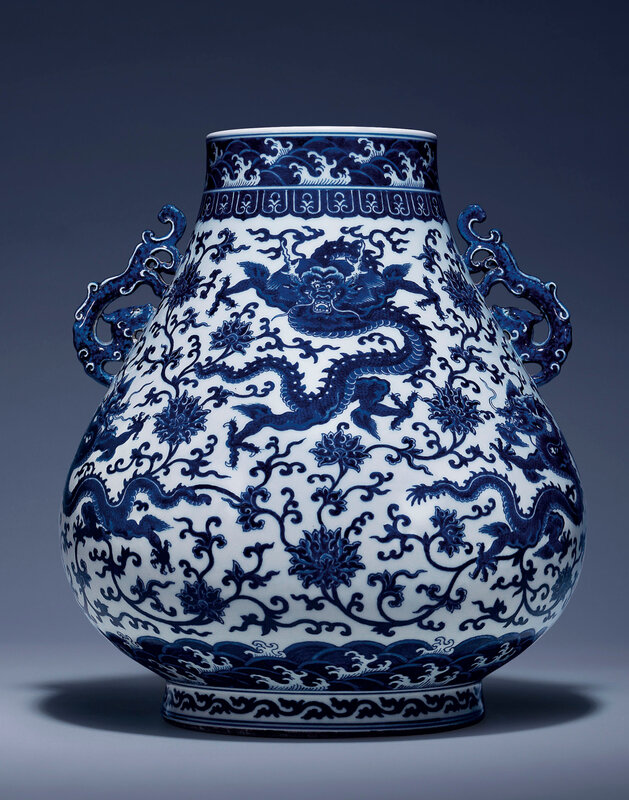

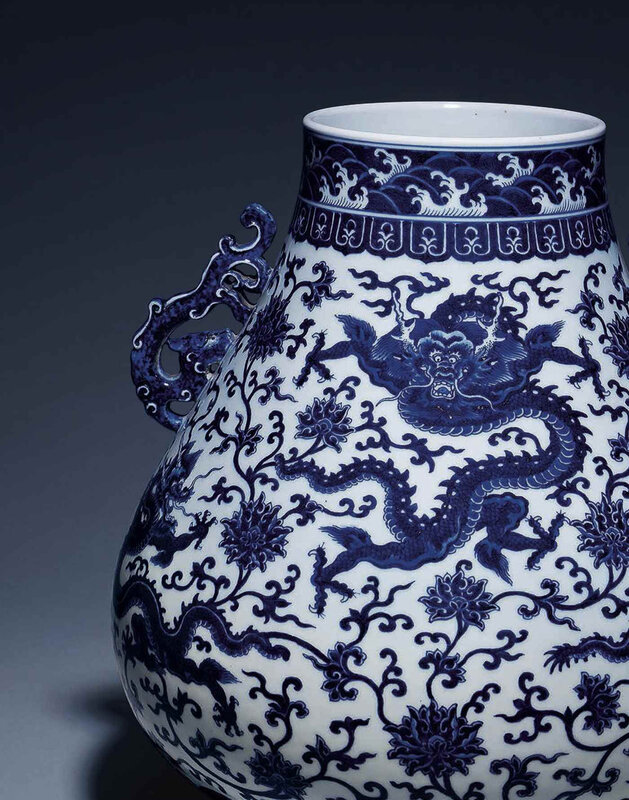

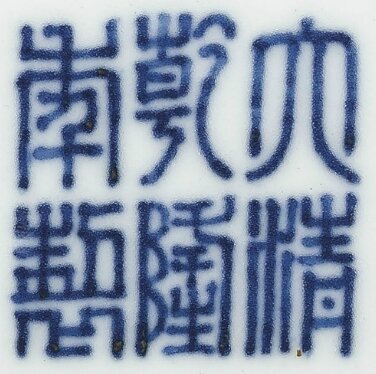



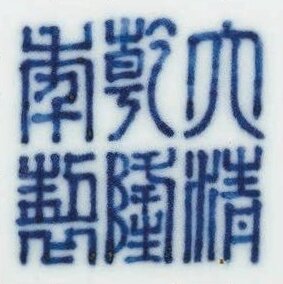




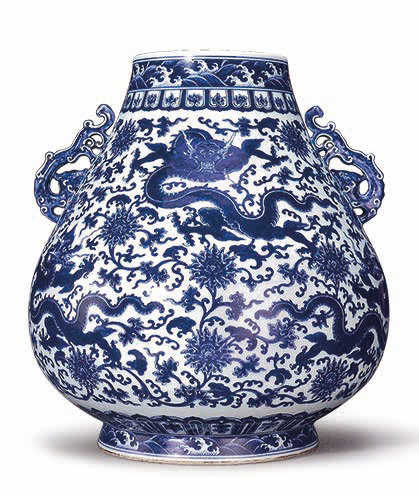



/image%2F1371349%2F20240416%2Fob_2a8420_437713933-1652609748842371-16764302136.jpg)
/image%2F1371349%2F20240414%2Fob_83ee65_2024-nyr-22642-0954-000-a-blue-and-whi.jpg)
/image%2F1371349%2F20240414%2Fob_15808c_2024-nyr-22642-0953-000-a-blue-and-whi.jpg)
/image%2F1371349%2F20240414%2Fob_e54295_2024-nyr-22642-0952-000-a-rare-blue-an.jpg)